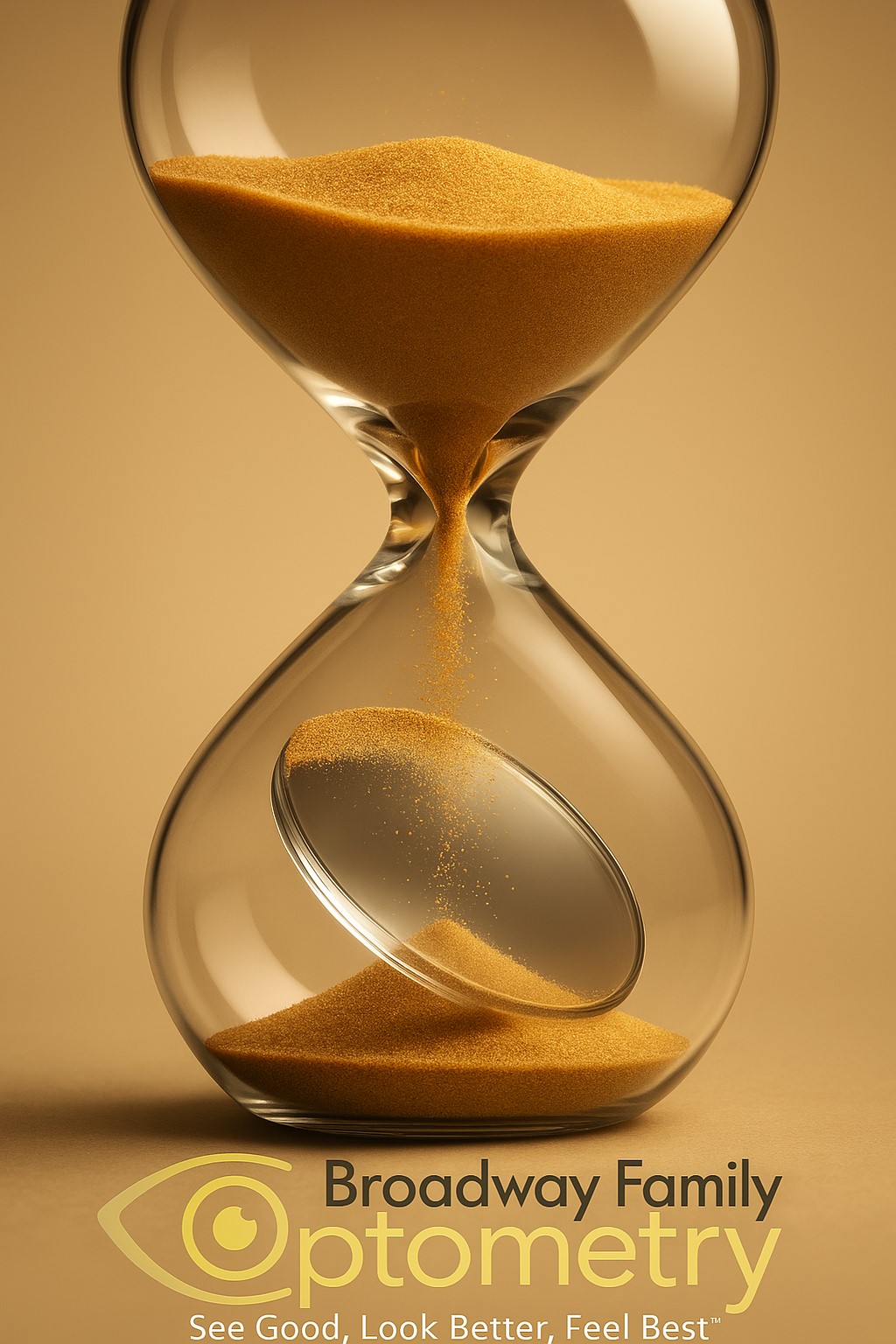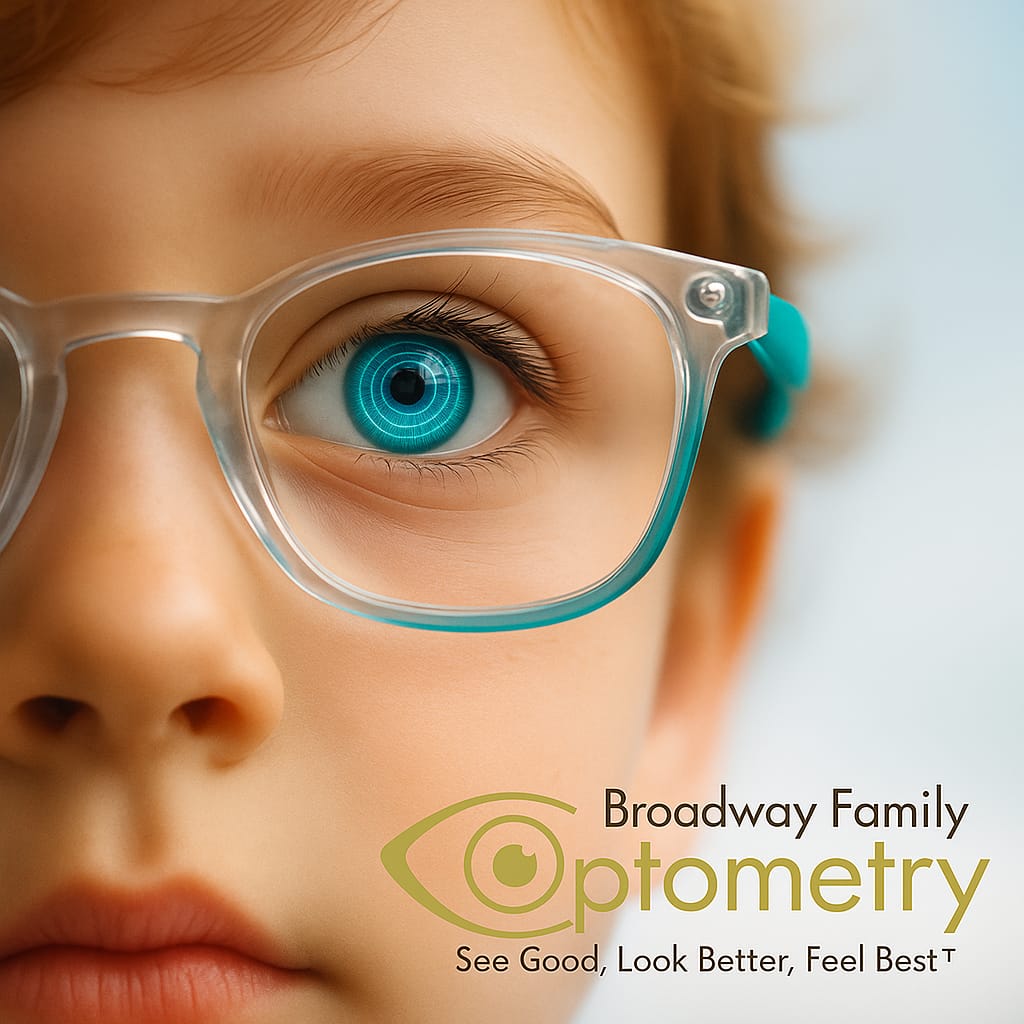Welcome to our Eye Health Library!
Here you’ll find trusted patient handouts on common eye conditions and our latest monthly eye health blog posts to help you care for your vision.

At Broadway Family Optometry, we believe that understanding your eye condition is a key part of taking care of your vision. That is why we have created this collection of easy-to-read guides to help you feel more confident, informed, and supported. Each guide below covers a common eye condition, what it means, and how it is treated. These are the same topics we often discuss in our visits together - now available for you to review anytime, at your own pace.
Click any condition below to open its guide.
Allergic Conjunctivitis
Amblyopia (Lazy Eye)
Bacterial Conjunctivitis
Blepharitis
Blepharospasm
Cataract
Central Serous Retinopathy (CSR)
Chalazion
Corneal Ulcer
Diabetic Retinopathy
Dry Eye Syndrome
Glaucoma (Early Stage)
Macular Degeneration (Dry Form)
Ocular Hypertension
Ocular Migraine
Pingueculae
Posterior Vitreous Detachment (PVD)
Pseudopapilledema
Pterygium
Retinal Detachment
Strabismus
Subconjunctival Hemorrhage
Uveitis
Viral Conjunctivitis
We are continuing to add more guides to this library. Please check back often for updates, or ask
our staff if you would like a printed copy at your next visit.
If you have questions about anything you read here, I encourage you to reach out.
We are here to help you see good, look better, and feel your best.
Warm regards,
Dr. Boris Mardian, O.D.
Click any condition below to open its guide.
Allergic Conjunctivitis
Amblyopia (Lazy Eye)
Bacterial Conjunctivitis
Blepharitis
Blepharospasm
Cataract
Central Serous Retinopathy (CSR)
Chalazion
Corneal Ulcer
Diabetic Retinopathy
Dry Eye Syndrome
Glaucoma (Early Stage)
Macular Degeneration (Dry Form)
Ocular Hypertension
Ocular Migraine
Pingueculae
Posterior Vitreous Detachment (PVD)
Pseudopapilledema
Pterygium
Retinal Detachment
Strabismus
Subconjunctival Hemorrhage
Uveitis
Viral Conjunctivitis
We are continuing to add more guides to this library. Please check back often for updates, or ask
our staff if you would like a printed copy at your next visit.
If you have questions about anything you read here, I encourage you to reach out.
We are here to help you see good, look better, and feel your best.
Warm regards,
Dr. Boris Mardian, O.D.
Your Eye-Care Team: Who Does What?
Dr. Boris Mardian OD
December 2025 (Holiday Edition)
Introduction
As the year comes to an end, many people take a moment to reflect on their health, their families, and the routines that support their well-being. Vision plays an important part in daily life, especially during the holiday season when we read, travel, cook, shop, and spend time with loved ones. Yet there can still be some confusion about the different professionals who care for our eyes.
This month, I would like to offer a clear and friendly explanation of how your eye-care team works. Optometrists and ophthalmologists each play important roles. Understanding these roles can help you feel informed and confident whether you are scheduling a routine exam, managing an ongoing condition, or preparing for a surgical procedure.

Why Understanding the Eye-Care Team Matter
Over the course of your life, you may see more than one type of eye-care provider. Each brings different training and strengths to your overall care. When you have a basic sense of who does what, it becomes easier to navigate eye-care decisions.
Both optometrists and ophthalmologists share the same goal. They protect and support your vision throughout your life
How Optometrists and Ophthalmologists Are Trained
Optometrists and ophthalmologists both complete extensive education in eye and vision care, although the training pathways are different.
Optometrists (ODs) complete:
- A four-year undergraduate degree
- Four years of optometry school to earn the Doctor of Optometry degree
- Optional additional training such as residency in areas like primary care, contact lenses, ocular disease, pediatrics, or vision therapy
Ophthalmologists (MD or DO) complete:
- A four-year undergraduate degree
- Four years of medical school to earn a medical degree
- A one-year internship
- A three-year ophthalmology residency
- Optional one or more years of subspecialty fellowship training, such as retina, cornea, glaucoma, pediatrics, oculoplastics, neuro-ophthalmology, or ocular oncology
What Optometrists Do
Optometrists, or ODs, are primary eye-care doctors. Their work includes:
- Comprehensive eye examinations.
- Prescription of glasses and contact lenses.
- Diagnosis and treatment of many common eye conditions such as dry eye, allergies, eye infections, and inflammation.
- Medical management of chronic issues, including glaucoma, uveitis, and ocular surface diseases.
- Preventive care and education that supports long-term visual health.
Optometrists often serve as the first point of care, and many non-surgical or ocular surface conditions can be evaluated and treated at this level. When specialized or surgical care is needed, optometrists coordinate with ophthalmologists to ensure smooth referral and follow-up.
What Ophthalmologists Do
Ophthalmologists, who hold either an MD or a DO degree, are medical doctors trained in the medical and surgical treatment of eye disease. Their training includes medical school, a residency in ophthalmology, and often additional fellowship training
Ophthalmologists commonly provide:
- Surgical procedures such as cataract surgery, glaucoma surgery, corneal transplants, and retinal operations.
- Advanced medical treatment for conditions involving the retina, optic nerve, cornea, and other ocular structures.
- Subspecialty care in such areas as retina, cornea, pediatric ophthalmology, neuro-ophthalmology, and oculoplastics.
Common Types of Ophthalmology Specialists
When your optometrist refers you to an ophthalmologist, you may hear different specialty titles. All of these doctors are ophthalmologists, although each has completed additional training in a focused are of eye care
Retina Specialist
Treats conditions such as diabetic retinopathy, macular degeneration, retinal tears, and retinal detachments.Glaucoma Specialist
Focuses on diagnosing and treating glaucoma, including medical, laser, and surgical care.Cornea Specialist
Treats diseases of the cornea and ocular surface. This includes corneal transplants, keratoconus, infections, and severe dry eye.Refractive Surgeon
Often called a LASIK surgeon. Performs vision correction procedures such as LASIK, PRK, and SMILE.Pediatric Ophthalmologist
Cares for children’s eye conditions, including amblyopia, congenital disorders, and childhood strabismus.Oculoplastic Surgeon
Performs eyelid surgery, treats tear duct problems, manages orbital conditions, and performs certain cosmetic procedures around the eyes.Neuro-Ophthalmologist
Evaluates vision problems related to the optic nerve and the brain and often collaborates with neurologists.Uveitis Specialist
Manages autoimmune, infectious, or inflammatory eye diseases that require specialized treatment.Ocular Oncologist
Treats tumors of the eye and surrounding structures.Cataract and Anterior Segment Surgeon
Many ophthalmologists perform cataract surgery, although some focus heavily on advanced cataract techniques and lens technologies.This variety of subspecialties ensures that patients receive highly focused care when a specific condition calls for advanced evaluation or treatment.

A Quick Statistical Snapshot
To give a sense of how eye-care providers are distributed across the United States, recent studies show an average of about 16 optometrists for every 100,000 Americans and about 6 ophthalmologists for every 100,000 Americans.
These numbers are national averages, and some communities have higher availability while others have fewer providers.
These statistics offer context. They are not meant to compare professions but simply to show how patients typically access eye care across the country.
How Optometrists and Ophthalmologists Work Together
The eye-care system functions best when both professions work as a team. Examples of collaboration include:
- Co-management of cataract and refractive surgery, with optometrists providing preoperative and postoperative care while ophthalmologists perform the surgery
- Shared care for chronic conditions such as glaucoma or diabetic eye disease
- Efficient referrals that ensure patients receive the right level of care at the right time
- Ongoing communication between providers that supports continuity of care
When to See Each Professional
For routine examinations, glasses and contact lenses, dry eye treatment, allergies, infections, and many non-surgical or ocular surface conditions, optometrists are often the first professionals patients visit. Their presence across many communities helps support timely access to primary eye care.
Your optometrist may recommend a visit to an ophthalmologist when:
- A surgical procedure is necessary
- Advanced medical evaluation is needed
- A subspecialist would offer the best outcome
The Benefit of a Team Approach
When optometrists and ophthalmologists work together, patients benefit from
- Convenient access to primary eye care
- Specialized expertise when required
- Smooth coordination that avoids unnecessary delays in diagnosis or treatment
- A patient-centered approach that keeps care organized and efficient
A Holiday Message From Our Practice
As this year comes to a close, I want to thank all of our patients for trusting us with your vision and eye health. It is a privilege to care for you and your families.
From my family and our team to yours, we wish you a joyful Christmas season and a healthy and happy New Year. May the coming year bring you comfort, clarity, and good vision in every aspect of life.
[Disclaimer: This blog post is intended for informational purposes only. Therefore, it should not be considered a substitute for professional medical advice. For individualized advice and recommendations, please contact Dr. Boris Mardian, OD, at any time.]
Copyright. Broadway Family Optometry